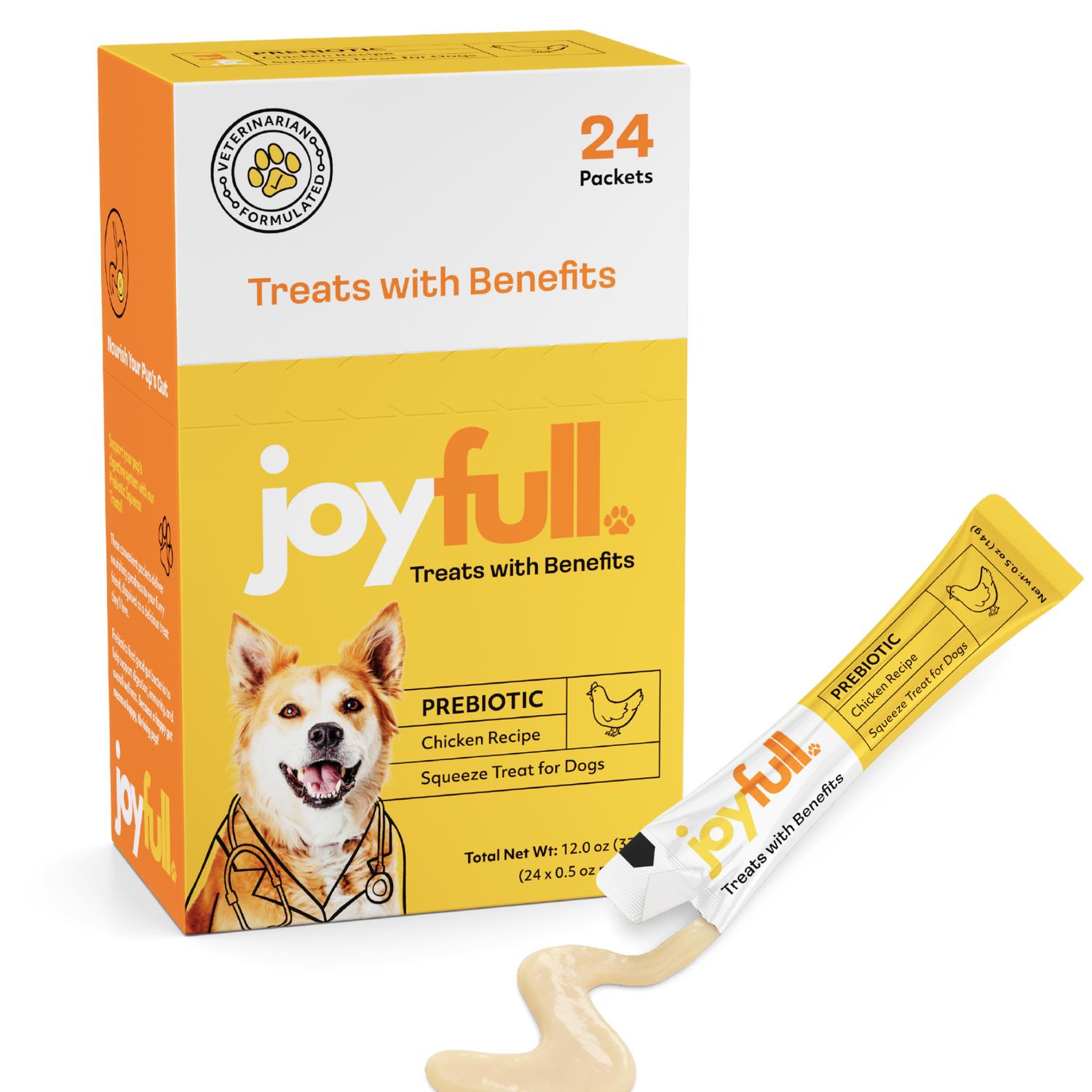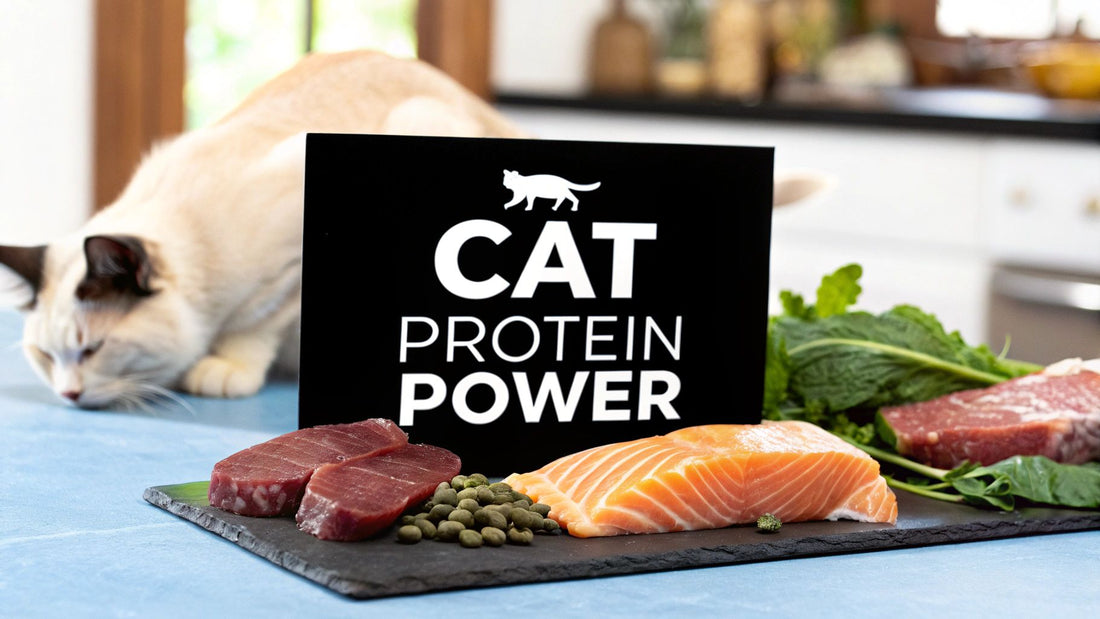
The Best High Protein Cat Food for Feline Health
When you're searching for the best high-protein cat food, you want to see a named animal protein, like chicken or salmon, right at the top of the ingredient list. It should also have minimal carbs and be designed for your cat's specific life stage. For our feline friends, protein isn't just one part of their diet—it is their diet. It's the essential fuel they need to truly thrive.
Why a High-Protein Diet Is a Game Changer for Cats
Ever watched your cat meticulously stalk a feather wand or a toy mouse? That laser focus isn't just them having fun; it's pure, hardwired instinct. Cats are obligate carnivores, which is a scientific way of saying their bodies are built to run on meat.
Think of it like a high-performance race car designed specifically for premium fuel. You wouldn't put regular unleaded in it and expect peak performance. For your cat, high-quality animal protein is that premium fuel.
This isn't a simple dietary preference—it's a biological command. Unlike omnivores like us or dogs, who can get nutrients from plants and animals, a cat's entire system is fine-tuned for a meat-based diet. Their short digestive tracts are made for rapidly processing protein and fat, not for struggling to break down tough, fibrous plants.
The Building Blocks of Feline Health
Protein delivers the essential amino acids that form the foundation for almost everything their body does. A diet packed with animal-based protein is crucial for:
- Lean Muscle Maintenance: Cats need plenty of protein to build and maintain the strong, agile muscles they use for jumping, climbing, and pouncing.
- Sustained Energy Levels: While we might reach for carbs for a quick boost, cats get their long-lasting energy primarily from protein and fat.
- Healthy Skin and a Shiny Coat: A cat's beautiful coat is made almost entirely of protein. If they're not getting enough high-quality protein, you'll often see it in their dull, brittle fur.
- A Strong Immune System: The antibodies that protect your cat from illness and infection are made from proteins. It's the cornerstone of their internal defense system.
A cat's body actually requires about five times more protein than a dog's. This incredible difference really drives home why a species-appropriate, protein-first diet is so vital for their health and happiness.
How This Shapes Today's Cat Food
Because cats are obligate carnivores, they absolutely must get their protein from animal sources to stay healthy and energetic. This biological reality is finally making a big impact on the pet food industry.
We're seeing a huge rise in demand for genuinely protein-rich foods—those containing 35% or more protein on a dry matter basis. In fact, somewhere between 70-80% of today's premium cat foods highlight high protein levels to better mirror what a cat would eat in the wild. If you're curious, you can explore further insights into these market trends to see how owner awareness is pushing for better feline nutrition.
This isn't just a passing fad. It’s a return to a more natural, biologically appropriate way of feeding our cats, making sure they get the powerhouse nutrition they were born to eat.
How to Actually Read a Cat Food Label
Walking down the pet food aisle can be overwhelming. Every bag and can makes a promise of health and happiness, but how do you cut through the marketing noise? The real story is always on the back of the package, and learning to read it is the most powerful tool you have. It all comes down to two key sections: the ingredient list and the guaranteed analysis.
Think of the ingredient list like a recipe—the ingredients are listed by weight, with the heaviest ones first. For a cat, this is non-negotiable: the first few ingredients absolutely must be high-quality, named sources of animal protein. Look for words like "deboned chicken," "turkey," or "salmon." Seeing a real, identifiable meat source at the top of the list tells you the food is built on a solid, species-appropriate foundation.
On the flip side, some labels are full of red flags. Vague terms like “meat by-products” or cheap, plant-based fillers such as “corn gluten meal” are signs of a lower-quality food. These ingredients just don't pack the same nutritional punch for your little carnivore and can be much harder for them to digest.
Understanding the Guaranteed Analysis
Next up is the Guaranteed Analysis. This is the pet food equivalent of a "Nutrition Facts" panel. It gives you the bare-bones breakdown of what’s inside, listing the minimum and maximum percentages of key nutrients.
Here’s what to focus on:
- Crude Protein: This number tells you the total amount of protein in the food. For a great dry kibble, you'll want to see a minimum of 35-40% crude protein. Wet food numbers look much lower (around 8-10%), but that's just because of all the water. To compare apples to apples, you have to look at the "dry matter basis."
- Crude Fat: Cats need healthy fats for energy. A good range for dry food is typically around 15-20%.
- Moisture: This one is pretty straightforward—it’s the water content. Dry food usually sits around 10% moisture, whereas wet food can be 75% water or even more.
This is a quick comparison to help you spot high-quality ingredients versus low-quality fillers on any cat food label.
Decoding Cat Food Label Terms
| Label Term | What to Look For (High-Quality) | What to Avoid (Low-Quality) |
|---|---|---|
| Protein Source | Named meats: Deboned Chicken, Turkey, Salmon, Lamb | Vague terms: Meat By-products, Poultry By-products, Meat and Bone Meal |
| Carbohydrates | Whole foods: Sweet Potatoes, Peas, Lentils | Fillers: Corn Gluten Meal, Wheat Gluten, Soy, Brewer's Rice |
| First Ingredient | A high-quality animal protein | A carbohydrate or a low-quality protein filler |
By keeping these simple distinctions in mind, you can quickly assess the quality of a food before it ever goes into your shopping cart.
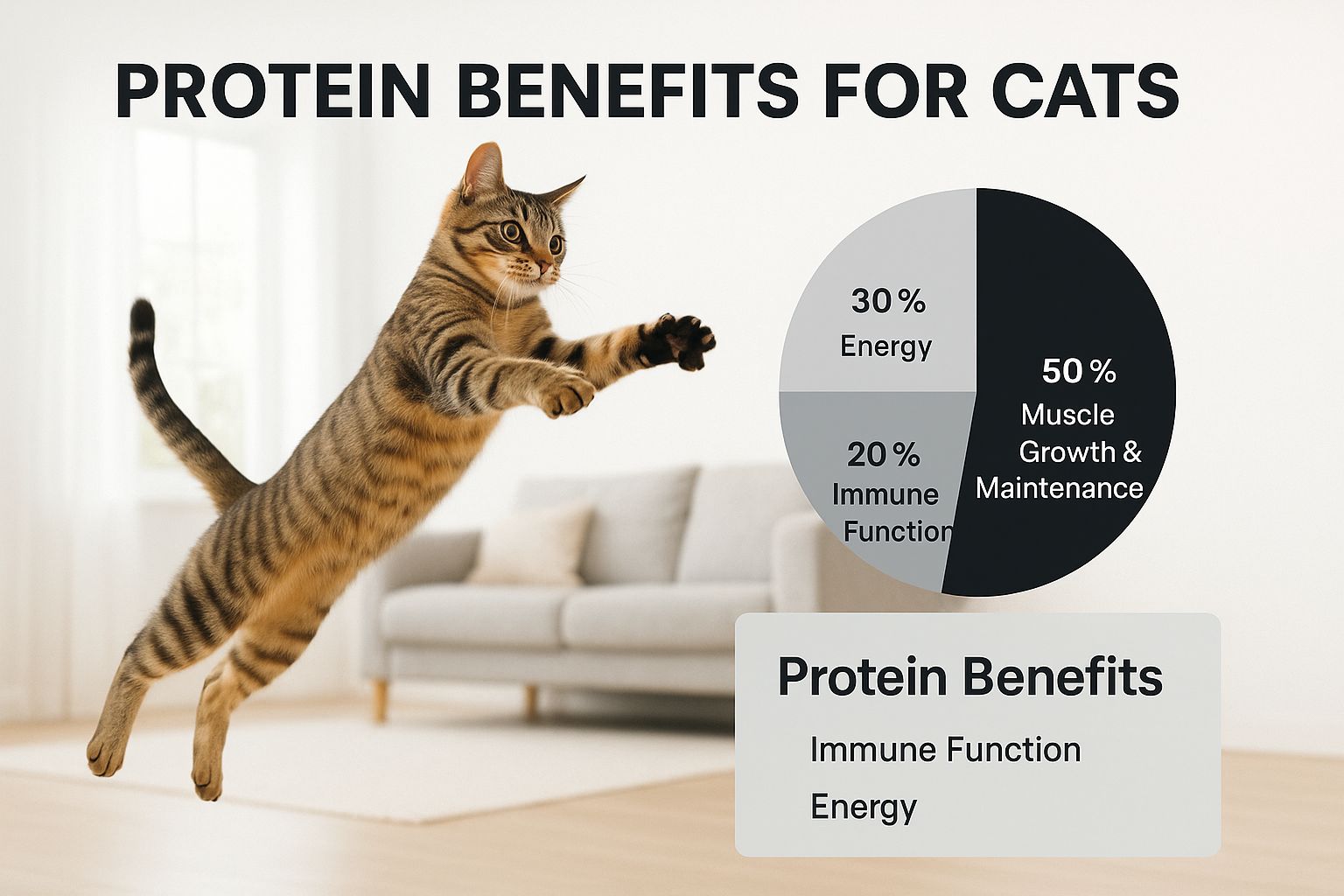
As you can see, every ounce of your cat's energy—from their playful pounces to their graceful leaps—is built on the foundation of high-quality animal protein.
Putting It All Together for Your Cat
So, what does this look like in the real world? An excellent food might list deboned chicken as its first ingredient and boast a 40% crude protein content. A less impressive option could start its list with corn, have "meat and bone meal" buried in the middle, and offer a meager 28% crude protein.
The difference is stark. One formula is designed around what your cat’s body is built to thrive on, while the other prioritizes cheap fillers over your cat’s health.
Knowing what to look for empowers you to make the best choice every single time. Choosing your cat’s food is one of the biggest factors in their long-term wellness. For an even more detailed breakdown, take a look at our complete guide on how to choose the best cat food. When you master the label, you’re not just buying dinner—you’re making a direct investment in your cat’s health and vitality for years to come.
The Best Animal Protein Sources for Your Cat
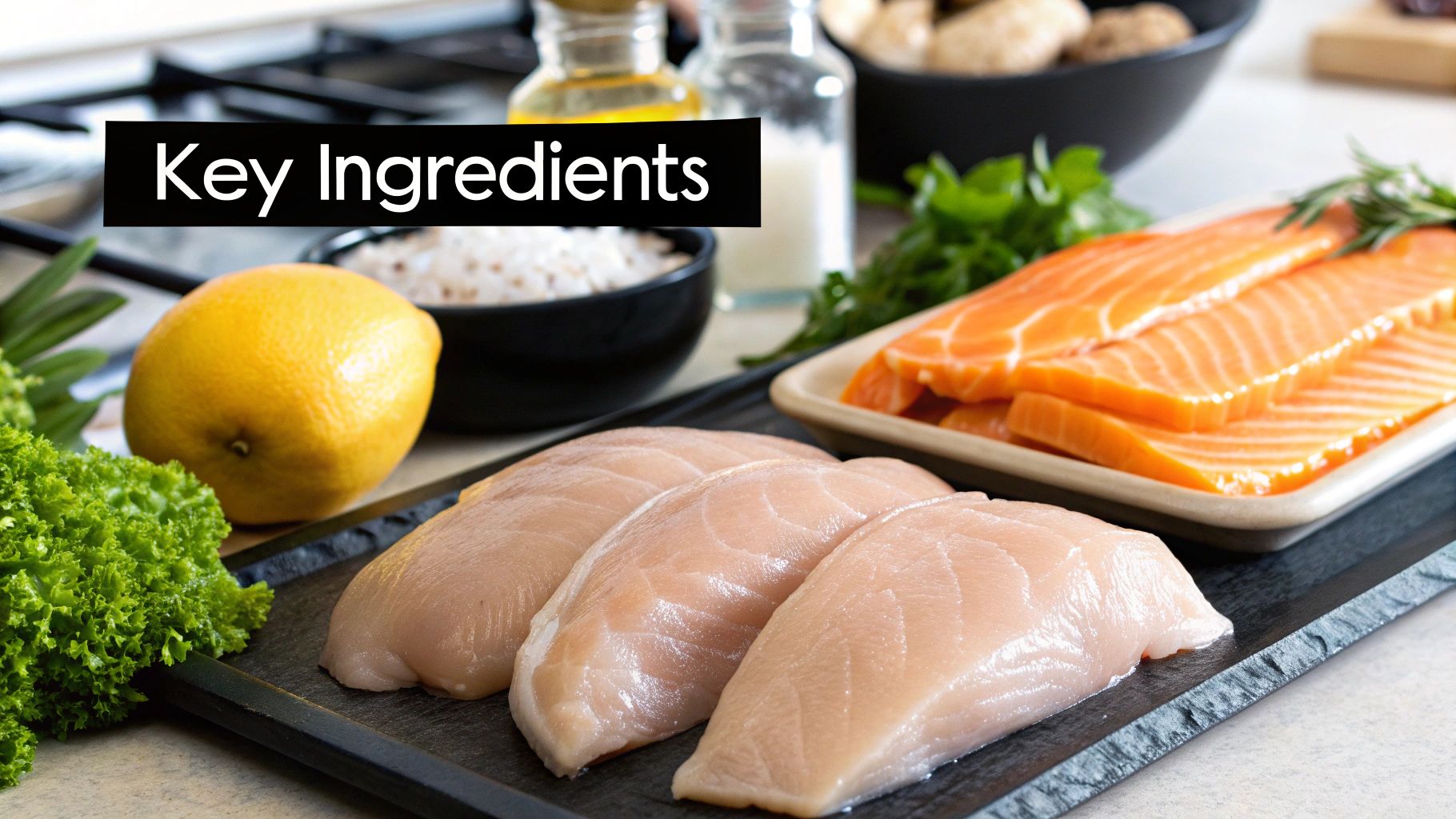
Okay, so you've got the hang of reading a cat food label. Now for the fun part: knowing which ingredients are the real superstars. For a true carnivore, not all proteins pack the same punch. The absolute best high protein cat food will always be built on a foundation of high-quality, clearly-named animal sources.
These ingredients deliver a complete amino acid profile, which is crucial for your cat’s health. Think of amino acids as individual LEGO bricks. Your cat's body needs a very specific set of these bricks to build and maintain everything from lean muscle to critical enzymes. Animal proteins provide all the essential bricks in a form their bodies are designed to use. It’s the perfect fuel.
Top-Tier Proteins for Feline Health
When you’re scanning that ingredient panel, you want to see these gold-standard proteins listed right at the top. They're highly bioavailable, which is just a technical way of saying your cat's body can easily absorb and put all those amazing nutrients to work.
- Chicken: This is a classic for a reason. It's a lean, highly digestible protein and a fantastic source of essential amino acids like taurine, which is non-negotiable for heart and eye health.
- Turkey: Another excellent lean protein, turkey is quite similar to chicken but offers a different flavor to keep things interesting. It’s great for supporting strong, healthy muscles.
- Salmon: Talk about a powerhouse. Salmon is loaded with protein and omega-3 fatty acids. This combo supports muscle health while also promoting that soft, shiny coat and healthy skin we all love.
- Beef: As a rich source of iron and protein, beef is a wonderful choice for energetic, active cats who need that dense fuel to power their daily zoomies.
At the heart of a clean-ingredient philosophy—like the one we have at JoyFull—is a simple promise: start with real, identifiable meats. This ensures the food has a rock-solid nutritional foundation, promoting well-being from the inside out for the long haul.
What About Food Sensitivities? Enter Novel Proteins
Just like us, some cats develop sensitivities to common proteins like chicken or beef. It happens. This is where "novel proteins" save the day. A novel protein is simply one your cat likely hasn't eaten before, which dramatically lowers the chance of an allergic reaction.
Some great examples include:
- Duck
- Rabbit
- Lamb
- Venison
It's no surprise that the pet food market is projected to hit USD 186 billion by 2028. Much of that growth comes from pet parents like you demanding more nutrient-dense and specialized diets. This awareness of pet allergies has pushed companies to innovate with hypoallergenic and single-protein formulas, giving us more ways to keep our sensitive felines happy.
Ultimately, choosing a food centered around a high-quality animal protein is the most direct way to honor your cat's natural dietary needs. This goes for their main meals and their snacks, too. That's why we've put together a guide on choosing high-protein cat treats that work with, not against, a healthy diet.
Matching Protein Needs to Your Cat's Life Stage
Cats aren’t static creatures, and neither are their dietary needs. A one-size-fits-all food just doesn't cut it when you consider how much a cat changes from a tiny, pouncing kitten to a serene, senior cat sunning on the windowsill.
Think of it like human nutrition: you wouldn't feed a growing toddler the same meal as a grandparent. Each phase of a cat's life comes with its own unique metabolic and energy demands. The best high protein cat food is one that respects where your cat is on their journey.
Kittens: Fueling the Growth Spurt
Kittens are basically little protein-powered growth machines. They seem to double in size overnight, and that incredible development takes a massive amount of fuel. The most important building block for them? Protein.
During their first year, kittens need a much higher protein percentage than adult cats. This isn't just for energy; it's to build everything from strong muscles and bones to healthy organs. Their food needs to be packed with high-quality, easy-to-digest animal protein to supply all the essential amino acids for building a healthy body from scratch.
Adult Cats: Maintaining a Healthy Prime
Once your cat hits their first birthday, the frantic growth period is over. Their nutritional needs pivot from building to maintaining. The goal now is to keep their lean muscle mass strong, support healthy organ function, and provide steady energy for all their important daily tasks—like chasing laser dots and napping strategically.
Even a laid-back adult cat needs a high-protein diet to stay lean and agile. Of course, you have to factor in their lifestyle. An indoor-only cat who spends most of the day lounging won't need the same calorie count as an outdoor explorer.
A common pitfall for cat owners is overfeeding, which can easily lead to obesity. A good high-protein food helps here by providing true, satisfying nutrition that supports muscle, not a bunch of empty carbohydrate fillers that just pack on the pounds.
Senior Cats: Supporting a Graceful Golden Age
When cats hit their golden years, usually somewhere around age 7 to 10, their bodies start to change. Their metabolism might slow down, and they're often less active. But here’s a common misconception: their need for high-quality protein doesn't go away. In fact, it might be more critical than ever.
Older cats can start to lose muscle mass, a condition called sarcopenia. A diet rich in highly digestible animal protein is one of the best tools we have to fight this, helping them keep their strength and mobility. It also supports their aging immune system, letting them live out their later years in comfort and health.
Common Myths About High Protein Diets for Cats
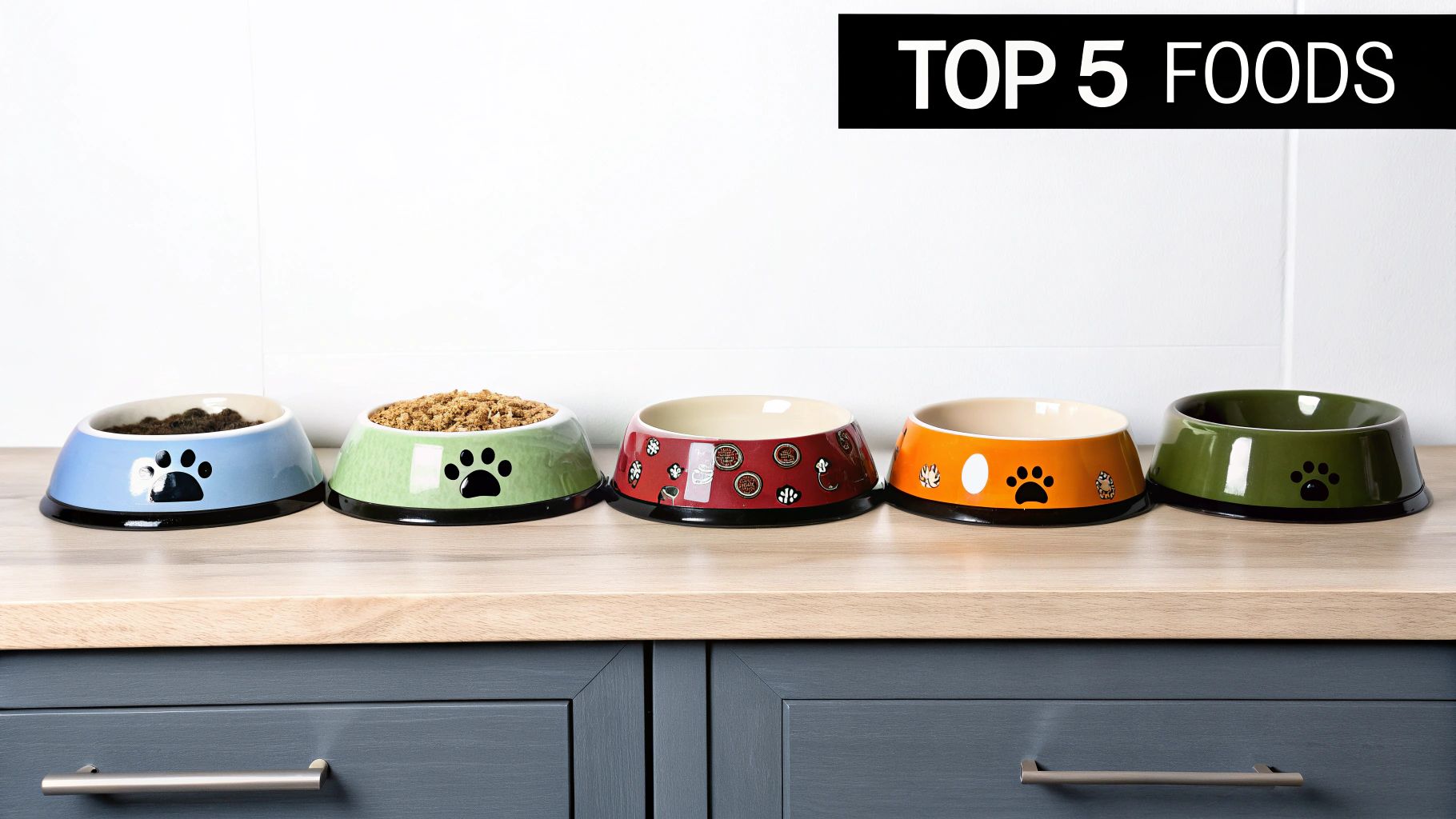
Trying to figure out the best way to feed your cat can feel overwhelming. There's so much conflicting information out there, especially when it comes to high-protein diets. Let’s cut through the noise and bust some of the biggest myths you’ve probably heard.
One of the most persistent worries is that a high-protein diet might damage a cat's kidneys. This idea has been around for a long time, but it’s based on old advice meant for pets who already have serious kidney problems.
For a healthy cat, there’s simply no scientific proof that a protein-rich diet is harmful. Think of it this way: your cat's body is a finely tuned machine built to run on animal protein. Depriving them of this crucial fuel doesn't make sense and can actually work against their overall health.
Debunking Common Misconceptions
Let's tackle two of the most common myths head-on. Getting the facts straight will empower you to choose your cat’s food with confidence.
Myth 1: Too Much Protein Causes Kidney Disease
Fact: This is a major misunderstanding for healthy cats. High-quality, digestible protein doesn't strain healthy kidneys. The real culprits are often poor-quality ingredients and chronic dehydration, not the protein itself. In fact, feeding them excellent animal protein is essential for maintaining strong muscles and good health for their entire lives.
The trouble starts when foods are packed with low-grade, plant-based proteins and cheap fillers that are tough for a cat’s system to process. You can see a full breakdown of what to watch out for in our guide on cat food ingredients to avoid.
Myth 2: "Grain-Free" and "High-Protein" Are the Same
Fact: These two terms are definitely not the same thing. A cat food can be labeled "grain-free" but be bulked up with starchy fillers like potatoes and peas, leaving its actual protein content disappointingly low. On the flip side, a high-protein food might include a small amount of beneficial grains.
The secret is to always check both the Guaranteed Analysis and the ingredient list. The number one thing you want to see is a named animal protein right at the top of the list. True quality isn't about the absence of one ingredient like grain; it's about a high percentage of protein that your cat’s body can actually use.
How to Switch Your Cat’s Food Without All the Drama
Alright, you’ve done the hard work. You’ve sifted through the options and picked out a fantastic, high-protein food for your cat. Now comes the real test: convincing your furry overlord to actually eat it.
If you’ve ever tried to change a cat’s food cold turkey, you probably know how that ends—with digestive upset or a hunger strike. The trick isn't just swapping out the food; it's a careful, gradual process. Think of it like this: you wouldn't jump straight from the couch into running a marathon. Your cat’s digestive system needs that same kind of gentle ramp-up to get used to the new, richer ingredients. A little patience now saves a lot of headaches later.
The Foolproof Seven-Day Transition Plan
This is the gold standard for a reason—it works. The idea is simple: you’ll slowly mix the new food into their old food, tipping the scales a little more each day over the course of a week.
- Days 1-2: Start with a mix of 75% old food and just 25% new food.
- Days 3-4: Move to a 50/50 split of old and new.
- Days 5-6: Now, we're at 25% old food and 75% new food. Almost there!
- Day 7: It's official! You can now serve 100% new food.
You're not alone in making this kind of switch. More and more cat owners are paying closer attention to what's in their pet's bowl. In fact, the global cat food market is expected to hit a staggering USD 91.3 billion by 2035, largely because people are seeking out high-protein, carnivore-appropriate diets. It’s a huge industry shift driven by owners just like you. If you're curious, you can explore more insights about the cat food market and see how this trend is changing what's available.
A Tip for the Truly Stubborn Cat: If your kitty turns their nose up at the new stuff, try this. Add just a splash of warm water or some low-sodium chicken broth to the bowl. It can really bring out the aroma and make the food much more tempting.
Once they’re fully transitioned, keep an eye out for the good stuff. You might notice their coat looks healthier and shinier, they have more pep in their step, or their litter box habits are more consistent. Those are the little signs that tell you you've made a great choice for their health.
Have More Questions? We've Got Answers.
When it comes to feeding our cats, it's natural to have a few questions. We get it. You want to make the absolute best choice for your furry family member, so let's clear up some of the common things we hear from cat parents just like you.
Think of this as a quick chat to iron out any last-minute curiosities, so you can feel great about what's going in their bowl.
What Protein Percentage Should I Look For?
For dry food, a great rule of thumb is to look for a crude protein level of at least 35%. Don't be alarmed if wet food labels show a much lower number, usually around 8-12% — that's simply because of the high moisture content.
The most telling sign of quality isn't just the percentage, but what's at the very top of the ingredient list. You always want to see a named animal protein, like "chicken" or "salmon," sitting in that number one spot.
Is Wet Food Better Than Dry Food?
This is the classic debate, but honestly, there's no single "best" answer. Both can be fantastic choices, as long as they're built on a foundation of high-quality ingredients.
- Wet Food: The biggest win here is hydration. Cats are notoriously poor drinkers, so the high moisture content in wet food is a lifesaver for supporting their kidney and urinary tract health.
- Dry Food: You can't beat the convenience and affordability of kibble, and its crunchy texture can help with dental hygiene. The key is finding a high-protein formula without a bunch of useless fillers.
A lot of cat owners find a "best of both worlds" approach works perfectly, feeding a mix of wet and dry food to cover all the bases.
At the end of the day, what matters most isn't whether it's wet or dry. The real goal is a species-appropriate diet packed with animal protein and low in carbs. That's the formula for a thriving cat.
Can High-Protein Food Really Help My Overweight Cat?
It sounds a bit backward, but yes, it's one of the best tools for the job. A high-protein, low-carb diet is incredibly effective for helping a cat lose weight safely and sustainably.
Protein is key because it promotes a feeling of fullness, which means less begging between meals. More importantly, it helps them hold on to their lean muscle while they shed fat. This keeps their metabolism humming along, ensuring they’re losing the right kind of weight, not the muscle they need to stay strong and active.
Ready to see what clean, protein-first nutrition can do for your cat? Check out JoyFull’s complete line of recipes, all crafted with top-tier animal proteins and absolutely no junk. Because a healthy, happy life isn't just for us. Discover the difference today.
